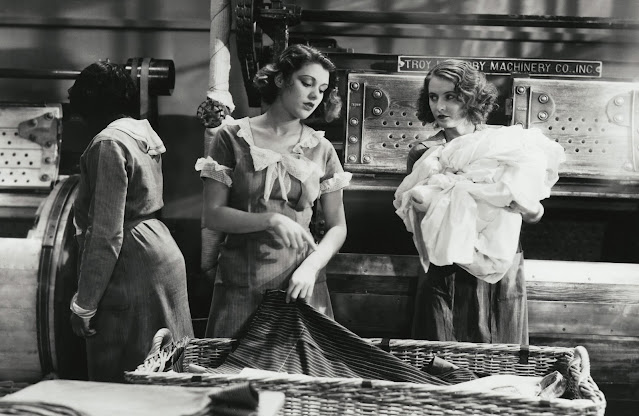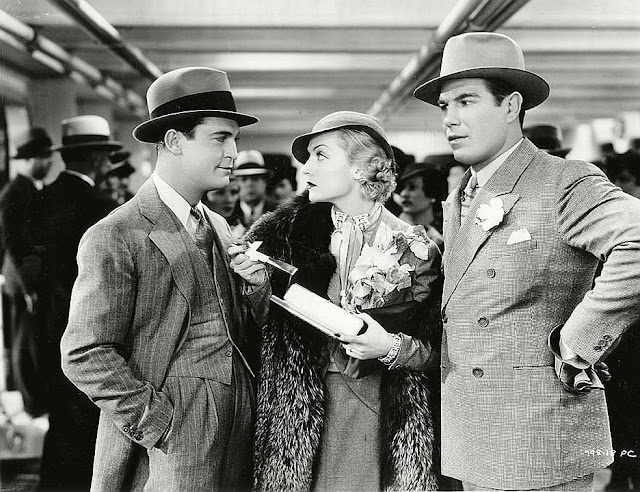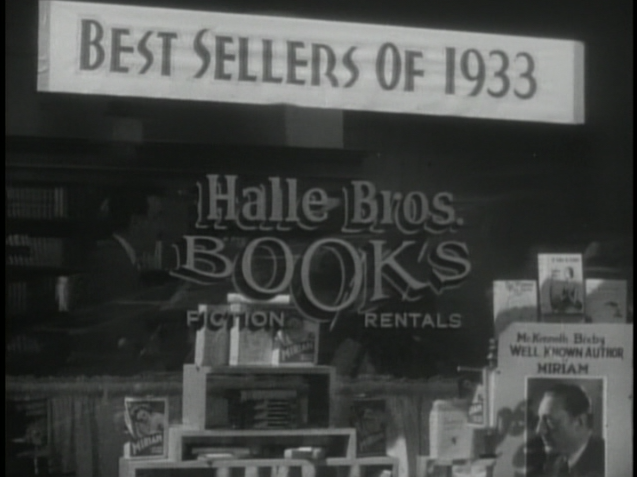 |
| Franchot Tone, Akim Tamiroff, Joan Crawford and Edward Arnold in Sadie McKee (1934) |
On the heels of
Dancing Lady (1933), MGM teamed up off screen couple
Joan Crawford and Franchot Tone for another on screen romance in
Sadie McKee (1944). But it seems like Hollywood wouldn't let Crawford be the apple of one eye. She has to be desired by several. Crawford stars as Sadie McKee, a maid working for the wealthy Alderson family. Michael Alderson (
Franchot Tone) has returned home to discover that Sadie has blossomed into a beauty. But Sadie is in love with the formerly employed Tommy (
Gene Raymond). The two run off to New York together and plan to marry. Sadie befriends Opal (
Jean Dixon), a street-wise dame with a penchant for a good time. While the two are waiting for Tommy to show up at the courthouse for the wedding, he runs off with show girl Dolly (
Esther Ralston). Sadie is destitute of both money and love. She starts a new life as a show girl (plus a little more) to make ends meet. That's when she meets the incredibly wealthy and incredibly drunk Jack Brennan (
Edward Arnold). Brennan is smitten with her and through marriage offers her an opportunity to get ahead. Sadie takes advantage of this even though it puts her in the precarious situation of taking care of an alcoholic. She also suffers the disdain of Brennan's friend and her old acquaintance Alderson and Brennan's staff including his butler Finnegan (
Leo G. Carroll). Sadie takes on the task of saving Brennan from himself, closing one chapter in her life and starting a new one.
From the very beginning it's established that Sadie McKee is the ideal physical specimen of womanhood. She has enough sass and sex appeal to keep men interested. And the three men she lures are all grossly inadequate. Tommy can't be held down, Brennan suffers from advanced alcoholism and Alderson is a spoiled rich playboy. Although Sadie is swayed by her emotions. she's the only one of the four who seems to have her shit together. She also has the support of her best friend and frequent voice of reason, Opal. The role of Sadie McKee fits Joan Crawford's persona perfectly. She
embodied the spirit of the working girl who moves up the ranks and
proves her worth. It's satisfying to watch her in parts like this. One could say that Sadie McKee is the pre-code precursor to
Mildred Pierce (1945).
1934 brought on a tougher enforcement of the Hays Production Code.
Sadie McKee slips in just in time and there are a few elements that classify it as a pre-code film. For example, the unmarried Sadie and Tommy sleep in the same bedroom together, albeit with her in the bed and him on the chair. Sexpot neighbor Dolly, played by Esther Ralston, channels Mae West and lures Tommy away from Sadie. When Dolly and Sadie have a showdown later in the film Dolly suggests that Sadie is a glorified prostitute.
Pre-Code expert Danny Reid also points out that when Opal and Sadie are at city hall waiting for Tommy, a police officer approaches them and asks if they're getting married. He says it in a way that both suggests they might be marrying each other but also that they're waiting for their fiancees. I'd also like to point out the scene in which Finnegan the butler, played by Leo G. Carroll in his first on screen role, undresses a drunk Brennan (Edward Arnold), preparing him for bed. It's an oddly intimate scene that lingers just enough to give time for the audience to wonder.
Sadie McKee is based on a story by Vina Delmar who wrote many novels, short stories and screenplays including
The Awful Truth (1937). She appears in the trailer for
Sadie McKee as you can see below. The story suffers from trying to do too much. It starts off as a sweet romance between two people who escape the upstairs-downstairs life for a fresh start in New York City. Then it takes a twist when it becomes a story of a poor show girl who marries a rich alcoholic. Then it takes a somber tone when the first couple are reunited. And then of course Franchot Tone's continual attraction and momentary disgust for Sadie/Crawford adds several more plot points. One could say that
Sadie McKee is an epic that didn't quite reach it's potential.
Even with its many flaws this is a gem of a film. Its such a joy to see cast members like Crawford, Tone, Arnold, Carroll, Raymond, Ralston and Dixon in action. Not to mention one of my personal favorites,
Akim Tamiroff who plays night club owner Riccorri. I'll watch him in anything. Also in the movie are singer Gene Austin and the jazz duo Candy and Coco who all make their screen debut and play a couple of numbers in the movie.
 |
| Sadie McKee ad from The Film Daily April-June 1934 |
Sadie McKee got mixed reviews but still proved profitable enough for MGM that after a batch of successful films Crawford was able to renegotiate her contract. According to Joan Crawford biographer Donald Spoto, Crawford said, "I was pretty unhappy with the way the picture was cut. Perhaps it will make sense, but I doubt it."
Interesting fact:
The Library Hotel in New York City plays Sadie McKee on a loop on a TV in their rooftop lounge. I've attended a few parties in that space and that movie is always on. I couldn't find any information why that film in particular was selected for the loop. It's a curious choice especially considering their rooftop bar is just around the corner. Maybe they thought a sobering film about alcoholism might encourage patrons to drink less.
Sadie McKee (1934) is available from the
Warner Archive Collection. You can buy the DVD-R from the WB Shop by using
this link.
Warner Archive Wednesday - On (random) Wednesdays, I review one title from the Warner Archive Collection. Thank you to the Warner Archive for sending me a copy of Sadie McKee (1934) for review!

















































